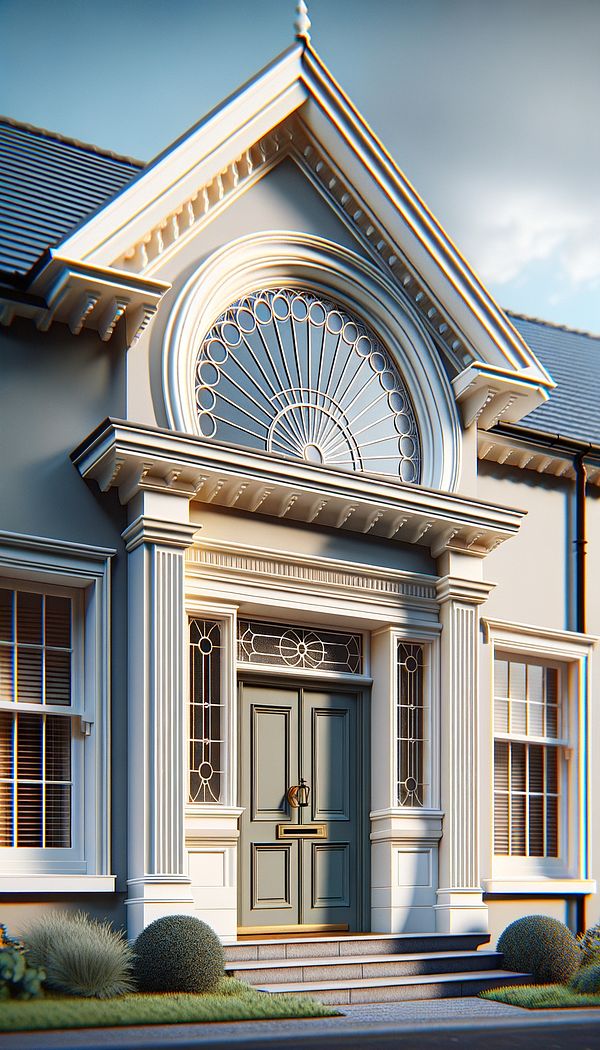What is a Fanlight?
A fanlight is a semi-circular or semi-elliptical window with glazing bars or tracery radiating out like a fan.
Description
Fanlights are a distinctive architectural feature primarily found above doors or windows, often in the transom area which is the space between the top of a door and the ceiling. Named for its shape that resembles an open fan, a fanlight can either be semi-circular, semi-elliptical, or occasionally rectangular with a rounded top, characterized by its multiple panes of glass separated by glazing bars or ornate tracery designed to radiate outward. This ornamental element not only adds aesthetic charm to a building's façade but also serves a practical purpose by allowing natural light to enter the space while maintaining privacy.
Originally popularized in the Georgian and Federal architectural periods, fanlights remain a symbol of elegance and are frequently included in the design of classical and traditional homes. They are especially valued in settings where maximizing natural light is desired without compromising on the architectural integrity and style of a space. In contemporary design, fanlights are often stylized and simplified, blending seamlessly with modern aesthetics while still serving their fundamental function of additional lighting.
Beyond their role in residential architecture, fanlights have found a place in commercial and public buildings, showcasing their versatility and timeless appeal.
Usage
Fanlights are commonly seen above front doors in traditional homes, serving as a decorative and practical feature. They are also found in historic buildings, adding to their architectural significance. In modern contexts, fanlights may be incorporated into commercial premises such as offices or restaurants, where they enhance both the interior and exterior appeal by allowing more daylight to penetrate the space.
FAQs
-
How does a fanlight differ from a regular window?
A fanlight differs from a regular window primarily in its shape and placement. It is typically semi-circular or semi-elliptical with radiating glazing bars or tracery, and installed above doors or in the transom area, rather than being used as a standalone window.
-
Can fanlights be opened?
Some fanlights are designed to be operational, allowing them to be opened for ventilation. However, many decorative fanlights, especially those found in historic buildings, are fixed and cannot be opened.
-
Are fanlights energy efficient?
Fanlights can contribute to energy efficiency by allowing natural light to enter a space, potentially reducing the need for artificial lighting. However, their energy efficiency also depends on the type of glazing used and whether the window is operable or fixed.
Practical Application
When considering adding a fanlight to your home or project, choose a design that complements the existing architectural style. For energy efficiency, look for options with modern glazing technologies. If ventilation is a priority, consider an operable fanlight model. Regardless of the style, a fanlight can significantly enhance both the aesthetics and functionality of a space.
-
Architectural Elements199 articles
-
Lighting111 articles
-
Decorative Techniques322 articles
-
Window Treatments65 articles
-
Historical Periods & Movements150 articles
-
SettleA settle is a traditional wooden bench with a high back and armrests.
-
Carver ChairA Carver Chair is a type of dining or armchair originating from the American colonies.
-
ShojiShoji refers to a traditional Japanese sliding panel that separates spaces or serves as a door or window.
-
GrommetA grommet is a ring or edge strip inserted into a hole through thin material, typically made of metal, rubber, or plastic.
-
Kick PleatA kick pleat is a single, inverted pleat typically located at the back of a skirt or at the bottom of a slipcover or curtain to allow for more freedom of movement.
